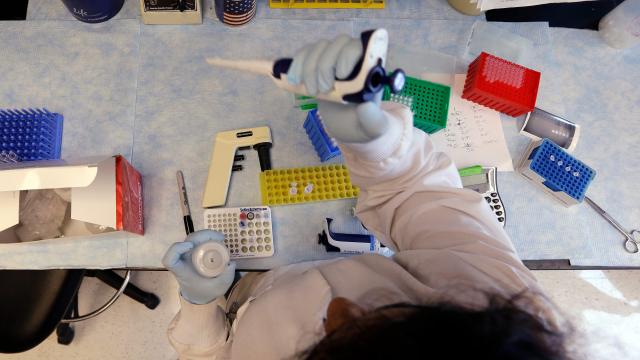A letter published in a scientific journal last year challenged the safety of promising gene-editing tool CRISPR, unnerving researchers and investors alike. Now, a smattering of recent studies have redeemed the technology by showing how CRISPR can more precisely target disease.
A research technician works to clone DNA in a lab. Photo: AP Images
The stocks of biotech firms invested in CRISPR tumbled last May after scientists published results showing that when they used CRISPR to cure blindness in mice, it resulted in not just a few but more than a thousand unintended effects. This suggested that if CRISPR were to be used to cure disease in humans, it could potentially result in disastrous side effects. It was a bucket of cold water on an industry intent on using CRISPR to cure countless diseases such as sickle cell anaemia and muscular dystrophy. The research did not go over well.
Then last month, another set of researchers replicated the study, finding the initial alarm was over-exaggerated – the result of sloppy science. Now, several more studies have bolstered confidence in CRISPR, shedding light on how to potentially limit any off-target effects that do occur.
While CRISPR is heralded as a precision technique that makes editing genes as simple as cutting and pasting, it is not quite as precise as headlines suggest, and off-target effects do happen. So scientists are developing ways to make that targeting more, well, targeted.
Sometimes, the molecule that guides CRISPR’s scissors to the right place to cut a genome also accidentally targets sequences of genetic code that are similar, but not an exact match.
One fix may be tweaking the enzymes in the CRISPR system that do the targeting, as researchers at the Broad Institute did in a study published last week in Nature. In that study, they tweaked the enzyme, Cas9, in such a way that it could not only target more regions of the genome at once, but also do so with more specificity.
In the case of so-called base-editors, which target individual letters of DNA, CRISPR might be trained to change a single genetic C to a T. Our genetic code is written in just four letters – A, C, T and G – so changing just one letter is sometimes all that’s necessary to fix a disease. Off-target effects could occur though, if the same letter occurs twice in the same snippet of code on which CRISPR is trained, also changing another C to a T accidentally.
In one yet-to-be-peer-reviewed paper, posted last week on the website BioRxiv, scientists at Massachusetts General Hospital developed a way to make base editors change that C to T only if, say, there’s a G before it. This extra step makes the editor less likely to make the wrong edit. The technique was tested on human cells in a lab. The tweaked editor still made some mistakes, but far fewer than the original version.
The possibility of unintended effects is still a concern in developing any CRISPR therapy – another study published online last week as a preprint showed that when using a “deliberately promiscuous” form of CRISPR in a mouse liver, there were hundreds of off-target gene edits.
But the rapid pace of advancement suggests the risks of off-target effects in CRISPR as not as high as once thought. That same study that used a promiscuous CRISPR found that when CRISPR was more appropriately designed, there were no detectable off-target effects. Scientists are well on their way to figuring out how to safely use this tool to cure disease in people.
